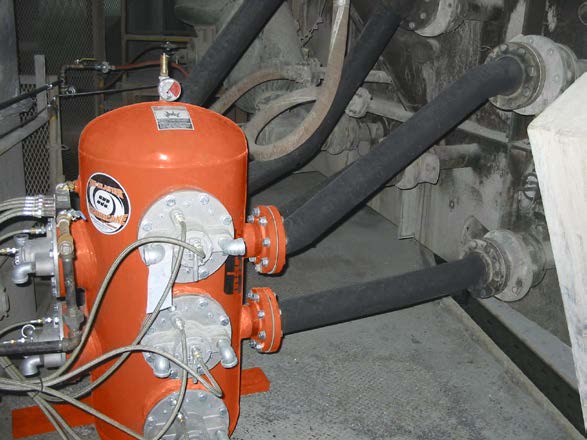Publicado: August 2nd 2016
 An innovative Midwest generation facility has specified a unique multi-port air cannon to prevent ash build-up in the plant’s Selective Catalytic Reduction (SCR) system, improving NOx reduction and eliminating the need for 2-3x yearly cleanouts. The company estimates that in addition to better system performance, the savings amount to $200,000-300,000 annually in contract labor costs.
An innovative Midwest generation facility has specified a unique multi-port air cannon to prevent ash build-up in the plant’s Selective Catalytic Reduction (SCR) system, improving NOx reduction and eliminating the need for 2-3x yearly cleanouts. The company estimates that in addition to better system performance, the savings amount to $200,000-300,000 annually in contract labor costs.
The facility is a 205 MW coal-fired plant that came online in 1970. Upgrades have been made throughout its lifespan, including a 1990 conversion to blend low-sulfur coal with local supplies to comply with new clean air standards. In 2007, the company added a sophisticated SCR system to further reduce NOx emissions, an investment larger than the cost to construct the plant originally.
Over time, operations personnel noticed a drop in SCR performance, and during a scheduled plant outage they inspected the system and discovered that fly ash contained in the exhaust stream was accumulating in the top layer. “The deposits became so severe along the front wall that they completely blocked the sonic horns which were in place to facilitate the ash flow,” recalled Martin Engineering Product Specialist Jeff Shelton. “At times, the plant would have to reduce the boiler load, due to poor NOx reduction.”
To address the situation, the plant was forced to enlist a contractor to come on-site 2-3 times each year during scheduled plant outages and evacuate the build-up. “The cleanout was an extensive process,” said one company official. “It required two vacuum trucks and operating crews for most of a week to remove the accumulated ash.”
In a move designed to implement a more permanent solution, facility engineers met with representatives from Martin Engineering and inspected the SCR system. Together they settled on a plan to first rebuild the sonic horns for maximum performance, followed by installation of a Martin® Multi Port Performance Air Cannon, with fan jet nozzles below the sonic horns.
The unique air cannon uses a single air reservoir and control unit to replace up to eight traditional (tank-and-valve) air cannons. With one air tank discharging through stainless steel hoses into as many as eight ports in the vessel wall, the Multi Port Performance Air Cannon improves process efficiency, while simplifying installation and maintenance.
“Reducing downtime is one of the key reasons customers specify a multi port air cannon,” observed Shelton. “Depending on the specific installation and operating environment, some air cannon designs can require such frequent maintenance that the production stoppages become a significant problem,” he said. “The multi port air cannon can be placed at a greater distance from the process, to minimize the effects of harsh environmental conditions.”
 The multi port approach also allows equipment to be positioned for easier access. Rather than having traditional tank-and-valve air cannons in locations that may be difficult to service, the multi port air cannon places the air reservoir and control mechanism in one central location, relaying the energy of the discharged air to the point of application through flexible steel hoses.
The multi port approach also allows equipment to be positioned for easier access. Rather than having traditional tank-and-valve air cannons in locations that may be difficult to service, the multi port air cannon places the air reservoir and control mechanism in one central location, relaying the energy of the discharged air to the point of application through flexible steel hoses.
“Any time you can perform maintenance or repairs without subjecting personnel to potential hazards, that’s a good thing,” commented Shelton. “When you combine that safety aspect and easier maintenance with the high reliability of the multi port approach, it delivers some valuable advantages, even beyond improved material flow.”
To initiate the firing sequence of a multi port air cannon, a solenoid valve is activated, allowing compressed air to fill the tank. At the same time, the air cylinder and isolation disk of the desired discharge port are retracted, opening the port to allow the air blast to release through it. The master cylinder and tank seal plunger are then retracted, evacuating the air from the tank through the open discharge port. As the air cannon resets, all cylinders return to their closed position, sealing off the unit from the process in preparation for the next firing sequence.
With the improved horn performance and addition of the air cannon, the SCR function was noticeably improved. Subsequent inspections revealed that over time, however, some build-up continued to form small piles in between the horns. Installing additional fan jet nozzles at the accumulation points appears to have resolved the issue, and the SCR system is functioning properly, no longer requiring manual cleanout.
The customer credits the air cannon with effectively preventing the build-up, an assessment that was confirmed when a scheduled shutdown permitted close inspection of the system and revealed very little accumulation. Eliminating the build-up has also opened up the gas lanes within the SCR, resulting in better NOx reduction. The performance improvement has allowed the facility to delay the purchase of replacement catalyst, which carries an estimated cost of $1,000,000.
“Efficient flow is a critical element of an efficient SCR system, and ash accumulation can put a strangle hold on a generating plant’s profitability,” Shelton concluded. “Although many plants still use manual techniques to remove build-up, the cost of labor and periodic shutdowns has led some producers to investigate more effective methods for dealing with this common issue.”